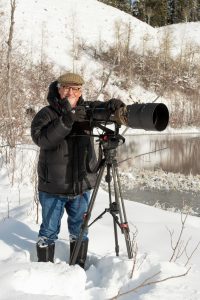
Renowned wildlife photographer Tom Mangelsen, who has a La Jolla gallery, is coming out with his eighth coffee table book in early October titled “Seasons of Yellowstone and Grand Teton National Parks.”
Mangelsen, whose Images of Nature Gallery is at 7916 Girard Ave., is also working on a new coffee table book, due out next spring, which is a sequel to “Grizzlies of Pilgrim Creek,” about the life of a grizzly bear mom dubbed 399 and her cubs in Yellowstone.
Both national parks are virtually in the backyard of the 76-year-old wildlife photographer, who lives on the edge of Grand Teton National Park, surrounded by it on three sides.
Mangelsen has traversed the globe shooting wildlife in their natural habitats: polar bears in Alaska, tigers in Asia, breathtaking landscapes in Antarctica, and waterfowl in his native Nebraska. He and his work were profiled in 2018 in an episode of “60 Minutes” by Anderson Cooper.
Of his latest wildlife photography book, Mangelsen noted it is about the seasons and the ecosystems of Yellowstone and Grand Teton National Parks, focusing on their well-known native wildlife.
“You find the same species, like the bison, in all four seasons with their young in the spring all the way through the winter standing in 3 or 4 feet of blowing snow, with the animals repeated in the different seasons with their babies and then juveniles,” he said.

Discussing how his latest book came about, Mangelsen said: “Yellowstone was the first real natural park in the world, created in 1872, and this year is its 150th anniversary. My publisher called me and asked me about doing another book for the park’s 150th anniversary. We actually set aside this next bear book to do that.”
Having photographed the world’s remaining wildest places for half a century, Mangelsen commented: “Unfortunately, our forefathers who set aside Yellowstone and Grand Teton, never imagined there would be 4 or 5 million people visiting Yellowstone in 2022. If they’d known, they’d have set aside more land, because we could certainly use more parks, which are all getting overcrowded, and somewhat loved-to-death in a way.”
Concerning his origins as a wildlife photographer, Mangelsen, was the second of four sons born to the owner of a five-and-dime store in Nebraska. His father was an avid bird hunter and fisherman. “I was probably the closest son that loved all that – so it’s all his fault,” he joked.
Mangelsen worked at the family business, along with his brothers, early on, but sought a career path far less well-traveled after being exposed by his dad and others to the natural world of waterfowl on the Platte River in Nebraska.
“I hunt with a camera today, I don’t need to go fishing or hunting anymore,” noted the wildlife photographer, who is a staunch conservationist who spends much of his time still out in the field. “Last year, I was out 150 days looking for (grizzly) 399 and her offspring and their families,” he said. “This year, I spent 84 days in the field after 399 had her four cubs, which is rare, and all of them survived.”
Concerning global warming, Mangelsen’s experienced it first-hand. “There is so much evidence all around, the massive fires in California and floods in Kentucky,” he pointed out. “I’ve given up trying to convince people if they’re so hard-headed that they can’t see what is obvious to so many people. I’ve seen glaciers in Antarctica 15 years ago, when I went back five years ago, the glaciers were all gone; they had melted. With all the climate change I’ve seen, anybody in their right mind would not doubt, not believe.”
Looking ahead, Mangelsen, whose favorite place to film in North America is Alaska and hasn’t been there since 2020, is anxious to return there. But right now, he’s content to be working on his next book, and a potential documentary, on 399, who is getting older, and her most recent batch of cubs. “I’d like to go back to India and photograph tigers.” Mangelsen said adding, “I’ve been all over the world the last 50 years.”









